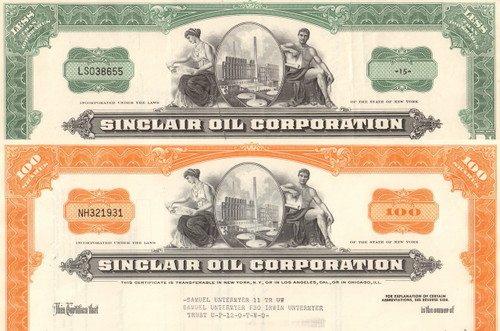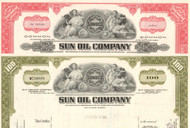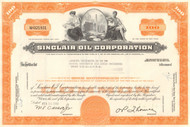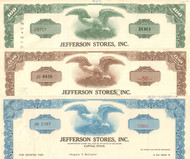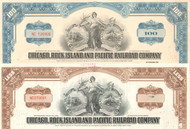Categories
Categories
- Home
- Stock Sets
- Company Sets
- Sinclair Oil Corporation 1960's- set of 2 colors
Sinclair Oil Corporation 1960's- set of 2 colors
Product Description
Sinclair Oil Corporation stock certificates 1960's - set of 2 colors
Nice oil piece with an appropriate vignette of an oil refinery flanked by classical male and female figures. Issued and cancelled. Dated 1960's. Great gift idea! This listing is for the set of 2 colors as shown. Individual pieces are available from the Oil category.
Set of 2 colors!
Sinclair Oil Corporation is an American petroleum corporation, founded by Harry F. Sinclair on May 1, 1916, as the Sinclair Oil and Refining Corporation by combining the assets of 11 small petroleum companies. Originally a New York corporation, Sinclair Oil reincorporated in Wyoming in 1976. The corporation's logo features the silhouette of a large green dinosaur.
During September 1919, Harry F. Sinclair restructured Sinclair Oil and Refining Corporation, Sinclair Gulf Corporation, and 26 other related entities into Sinclair Consolidated Oil Corporation. In 1932, this new entity was renamed Consolidated Oil Corporation. In 1943, it was renamed Sinclair Oil Corporation.
Near the beginning of the Great Depression, Sinclair sold the remaining interest in its pipeline subsidiary to Standard Oil Company (Indiana) for US$72.5 million (Standard Oil had purchased a 50% interest in the pipeline subsidiary in 1921). With these funds, including an additional US$33.5 million from an additional common stock issue, Sinclair retired a number of promissory notes and prepared to weather the Depression with the remaining supply of cash.
During the Great Depression, Sinclair saved a number of other petroleum companies from receivership or bankruptcy, and acquired others to expand its operations. In 1932, Sinclair purchased the assets of Prairie Oil and Gas's pipeline and producing companies in the southern United States, and the Rio Grande Oil Company in California. The purchase of Prairie also gave Sinclair a 65% interest in Producers and Refiners Corporation(Parco), which Sinclair subsequently acquired when Parco entered receivership in 1934. Lastly, in 1936, Sinclair purchased the East Coast marketing subsidiary of Richfield Oil Company, which had operated in receivership for several years. Richfield then reorganized, resulting in the creation of the Richfield Oil Corporation. Sinclair was instrumental in transferring capital and managerial assets into Richfield. Thirty years later, Richfield merged with Atlantic Refining, located on the East Coast, forming Atlantic Richfield.
At the Chicago World's Fair of 1933–1934, Sinclair sponsored a dinosaur exhibit meant to point out the putative correlation between the formation of petroleum deposits and the time of dinosaurs, now a largely discredited misconception. The exhibit included a two-ton animated model of a brontosaurus. The exhibit proved so popular it inspired a promotional line of rubber brontosaurs at Sinclair stations, complete with wiggling heads and tails, and the eventual inclusion of the brontosaur logo. Later, inflatable dinosaurs were given as promotional items, and an anthropomorphic version appeared as a service-station attendant in advertisements. Some locations have a life-size model of the mascot straddling the building's entrance.
At the New York World's Fair of 1964–1965, Sinclair again sponsored a dinosaur exhibit, "Dinoland", featuring life-size replicas of nine different dinosaurs, including their signature brontosaurus. Souvenirs from the exhibit included a brochure ("Sinclair and the Exciting World of Dinosaurs") and molded plastic figurines of the dinosaurs featured. After the Fair closed, Dinoland spent a period of time as a traveling exhibit.
In 1955, Sinclair ranked 21st on the Fortune 500; by 1969, it had fallen to 58th. In 1969, Sinclair was acquired by the Atlantic Richfield Company (ARCO). Federal antitrust provisions required the new entity to divest itself of certain Sinclair assets, and as a result, the East Coast operations of Sinclair were sold to BP (which has since purchased ARCO). After the acquisition by ARCO, the dinosaur was phased out, but at least one service station, in Winona, Minnesota, retained the original look through the 1980s. Many Sinclair stations in the Midwest continued to use the dinosaur logo along with ARCO's "diamond spark" logo. At least some Sinclair stations partially retained the Sinclair brand for a time, using ARCO's blue rectangular logo including the "spark" graphic, but with the word "Sinclair" substituted for ARCO.
In 1976, ARCO spun off Sinclair by selling certain assets to Robert (Earl) Holding. Sinclair has been owned by the Holdings since 1976. Assets divested in the spin-off included ARCO's retail operations in the region bounded by the Mississippi River and the Rocky Mountains, and the rights to the Sinclair brand and logo, resulting in many stations along Interstate 80 keeping the dinosaur logo. The ARCO stations in Texas, New Mexico, Illinois and some portions of Oklahoma were not affected by the divesture, and they continued as part of ARCO until ARCO pulled out of those states in the 1980s.
Currently headquartered in Salt Lake City, Sinclair is the 51st-largest private company in the United States. There are 2,607 Sinclair filling stations in 20 states in the Western and Midwestern United States. As of 2010, the corporation currently operates two refineries — one in Casper, Wyoming, and one in Sinclair, Wyoming. Sinclair operated a third refinery in Tulsa, Oklahoma until it was sold to Holly Corporation on December 1, 2009. Sinclair's other operations include 1,000 miles of pipeline.
Sinclair continues to use the green dinosaur, affectionately called "Dino", and markets all its products under the logo. Sinclair patented the gasoline additive SG-2000. The high-octane fuel blend is called "Dino Supreme" and regular gas is "Dino", trade names used since 1961, when many oil companies still used trade names for their fuels instead of generic terms such as "regular," "premium," or "unleaded". Prior to that time, Sinclair's trade names for its gasoline products included "Power X" for high-octane fuel and "Sinclair H-C" for regular gas. Sinclair also has marketed products such as Dino, Dino Supreme and Opaline motor oils.
 Loading... Please wait...
Loading... Please wait... 
